Delta Electronics E804WAG Dual-Band Wireless A+G Router User Manual P74743 F6D3230 4 AG man 12 04 indd
Delta Networks, Inc. Dual-Band Wireless A+G Router P74743 F6D3230 4 AG man 12 04 indd
Contents
Users manual 5
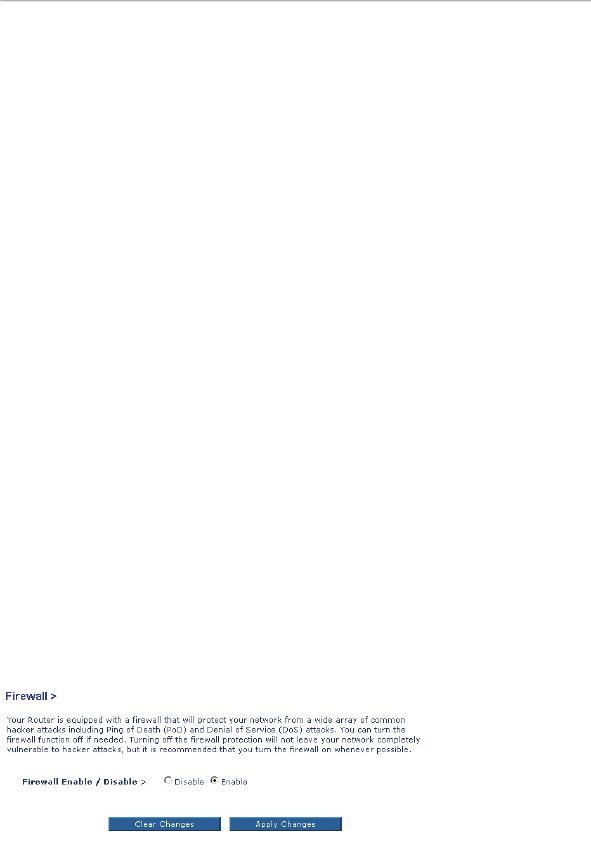
56
Using the Web-Based Advanced User Interface
Using the Web-Based Advanced User Interface
Configuring the Firewall
Your Router is equipped with a firewall that will protect your network
from a wide array of common hacker attacks including:
• IP Spoofing
• SYN flood
• Land Attack
• UDP flooding
• Ping of Death (PoD)
• Tear Drop Attack
• Denial of Service (DoS)
• ICMP defect
• IP with zero length
• RIP defect
• Smurf Attack
• Fragment flooding
• TCP Null Scan
The firewall also masks common ports that are frequently used to
attack networks. These ports appear to be “stealth”, meaning that for
all intents and purposes, they do not exist to a would-be hacker. You
can turn the firewall function off if needed; however, it is recommended
that you leave the firewall enabled. Disabling the firewall protection will
not leave your network completely vulnerable to hacker attacks, but it
is recommended that you leave the firewall enabled.
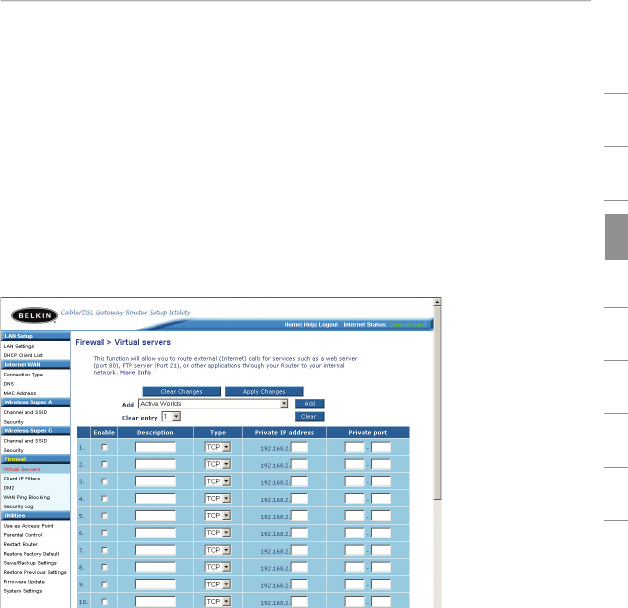
Using the Web-Based Advanced User Interface
57
section
1
2
3
4
5
6
7
8
9
Configuring Internal Forwarding Settings
The Virtual Servers function will allow you to route external (Internet)
calls for services such as a web server (port 80), FTP server (Port 21), or
other applications through your Router to your internal network. Since
your internal computers are protected by a firewall, computers outside
your network (over the Internet) cannot get to them because they cannot
be “seen”. A list of common applications has been provided in case you
need to configure the Virtual Server function for a specific application.
If your application is not listed, you will need to contact the application
vendor to find out which port settings you need.
Choosing an Application
Select your application from the drop-down list. Click “Add”. The
settings will be transferred to the next available space in the screen.
Click “Apply Changes” to save the setting for that application. To
remove an application, select the number of the row that you want to
remove then click “Clear”.
Manually Entering Settings into the Virtual Server
To manually enter settings, enter the IP address in the space provided
for the internal (server) machine, the port(s) required to pass (use a
comma between multiple ports), and then select the port type (TCP
or UDP) and click “Apply Changes”. You can only pass one port
per internal IP address. Opening ports in your firewall can pose a
security risk. You can enable and disable settings very quickly. It is
recommended that you disable the settings when you are not using a
specific application.
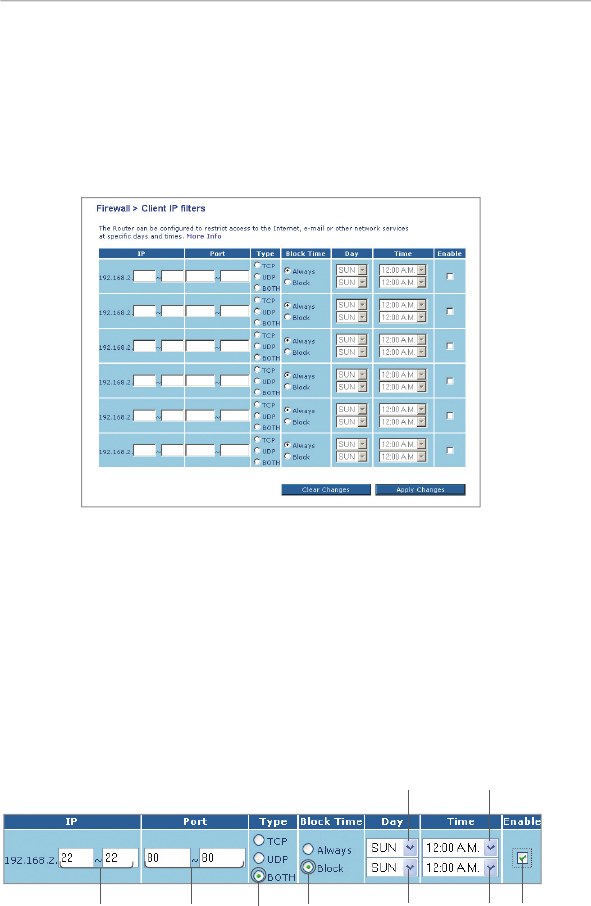
58
Using the Web-Based Advanced User Interface
Using the Web-Based Advanced User Interface
Setting Client IP Filters
The Router can be configured to restrict access to the Internet, email,
or other network services at specific days and times. Restriction can
be set for a single computer, a range of computers, or
multiple computers.
To restrict Internet access to a single computer, for example, enter
the IP address of the computer you wish to restrict access to in the
IP fields
(1)
. Next, enter “80” in both the port fields
(2)
. Select “Both”
(3)
. Select “Block”
(4)
. You can also select “Always” to block access
all of the time. Select the day to start on top
(5)
, the time to start on
top
(6)
, the day to end on the bottom
(7)
, and the time to stop
(8)
on
the bottom. Select “Enable”
(9)
. Click “Apply Changes”. The computer
at the IP address you specified will now be blocked from Internet
access at the times you specified.
Note:
Be sure you have selected the correct time zone under
“Utilities> System Settings> Time Zone”.
(1)
(2)
(3)
(4)
(7)
(8)
(9)
(5)
(6)
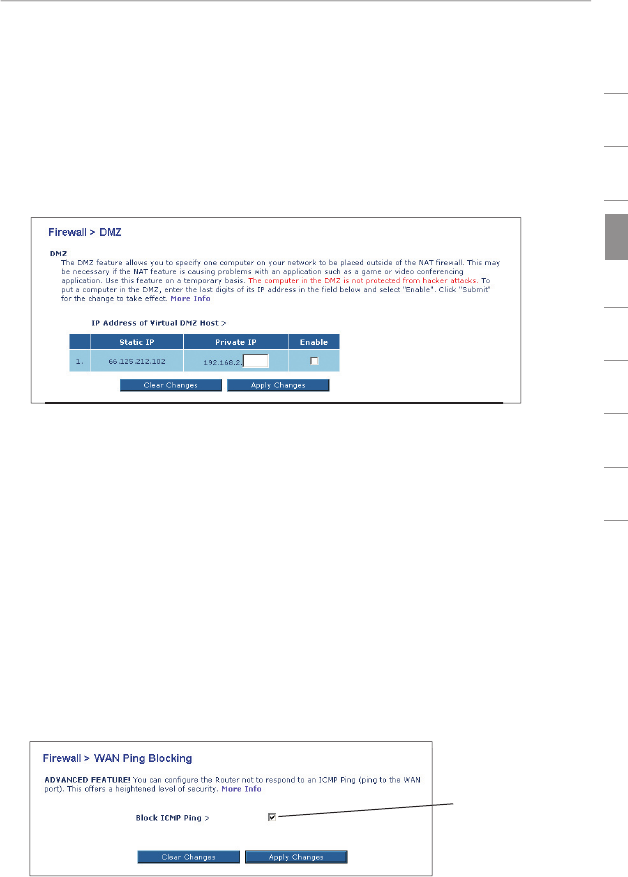
Using the Web-Based Advanced User Interface
59
section
1
2
3
4
5
6
7
8
9
Enabling the Demilitarized Zone (DMZ)
The DMZ feature allows you to specify one computer on your network
to be placed outside of the firewall. This may be necessary if the
firewall is causing problems with an application such as a game or
video conferencing application. Use this feature on a temporary basis.
The computer in the DMZ is NOT protected from hacker attacks.
To put a computer in the DMZ, enter the last digits of its IP address in
the IP field and select “Enable”. Click “Apply Changes” for the change
to take effect. If you are using multiple static WAN IP addresses, it is
possible to select which WAN IP address the DMZ host will be directed
to. Type in the WAN IP address you wish the DMZ host to direct to,
enter the last two digits of the IP address of the DMZ host computer,
select “Enable” and click “Apply Changes”.
Blocking an ICMP Ping
Computer hackers use what is known as “pinging” to find potential
victims on the Internet. By pinging a specific IP address and receiving
a response from the IP address, a hacker can determine that something
of interest might be there. The Router can be set up so it will not
respond to an ICMP ping from the outside. This heightens your Router’s
security level
.
To turn off the ping response, select “Block ICMP Ping”
(1)
and click
“Apply Changes”. The Router will not respond to an ICMP ping.
(1)
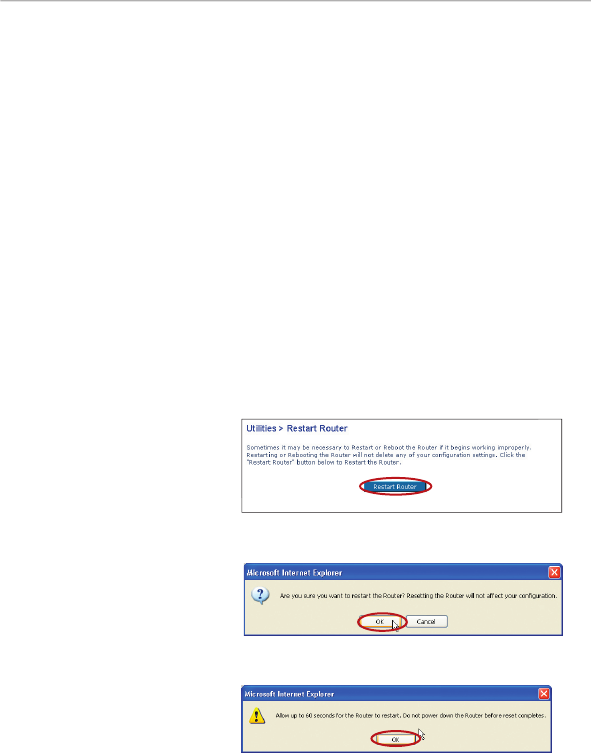
60
Using the Web-Based Advanced User Interface
Using the Web-Based Advanced User Interface
Utilities
The “Utilities”
screen lets you manage different parameters of the
Router and perform certain administrative functions.
Parental Control
See the included Parental Control User Manual for more information on
the Parental Control feature.
Restarting the Router
Sometimes it may be necessary to restart or reboot the Router if it
begins working improperly. Restarting or rebooting the Router will
NOT delete any of your configuration settings.
Restarting the Router to Restore Normal Operation
1.
Click the “Restart
Router” button.
2.
The following message
will appear. Click “OK”.
3.
The following message
will appear. Restarting
the Router can take
up to 60 seconds. It is
important not to turn off
the power to the Router
during the restart.
4.
A 60-second countdown will appear on the screen. When the
countdown reaches zero, the Router will be restarted. The Router
home page should appear automatically. If not, type in the
Router’s address (default = 192.168.2.1) into the navigation bar of
your browser.
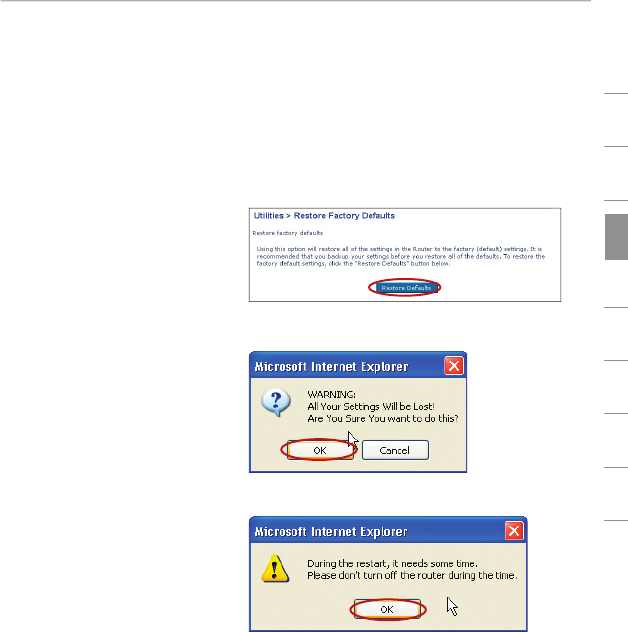
Using the Web-Based Advanced User Interface
61
section
1
2
3
4
5
6
7
8
9
Restoring Factory Default Settings
Using this option will restore all of the settings in the Router to the
factory (default) settings. It is recommended that you back up your
settings before you restore all of the defaults.
1.
Click the “Restore
Defaults” button.
2.
The following message
will appear. Click “OK”.
3.
The following message
will appear. Restoring
the defaults includes
restarting the Router.
It can take up to 60
seconds. It is important
not to turn the power
to the Router off during
the restart.
4.
A 60-second countdown will appear on the screen. When the
countdown reaches zero, the Router’s defaults will be restored.
The Router home page should appear automatically. If it does
not, type in the Router’s address (default = 192.168.2.1) into the
navigation bar of your browser.
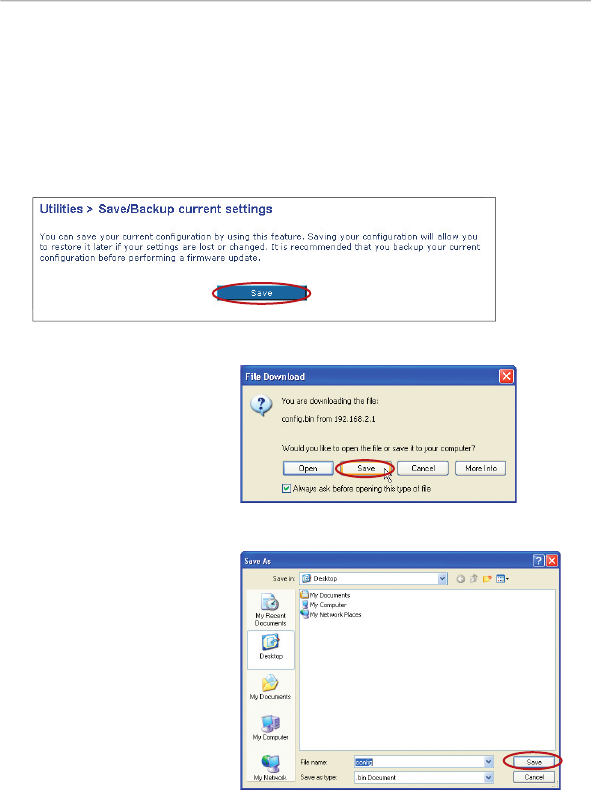
62
Using the Web-Based Advanced User Interface
Using the Web-Based Advanced User Interface
Saving a Current Configuration
You can save your current configuration by using this feature. Saving
your configuration will allow you to restore it later if your settings are
lost or changed. It is recommended that you back up your current
configuration before performing a firmware update.
1.
Click “Save”. A window
called “File Download”
will open. Click “Save”.
2.
A window will open
that allows you to
select the location
where you want to
save the configuration
file. Select a location.
You can name the file
anything you want, or
use the default name
“Config”. Be sure to
name the file so you
can locate it yourself
later. When you have
selected the location
and name of the file,
click “Save”.
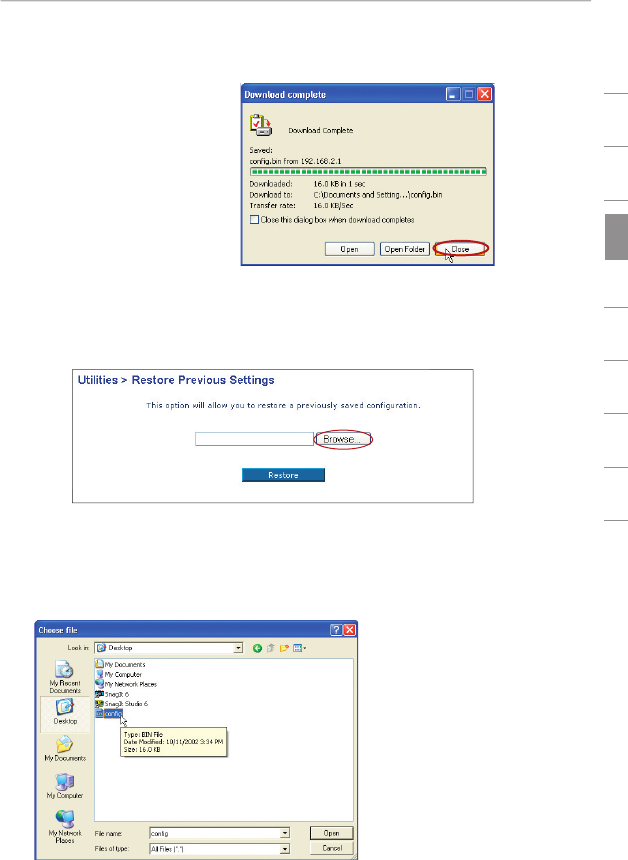
Using the Web-Based Advanced User Interface
63
section
1
2
3
4
5
6
7
8
9
3.
When the save is
complete, you will see
the following window.
Click “Close”.
The configuration is
now saved.
Restoring a Previous Configuration
This option will allow you to restore a previously saved configuration.
1.
Click “Browse”. A window will open that allows you to select the
location of the configuration file. All configuration files end with
a “.bin”. Locate the configuration file you want to restore and
double-click on it.
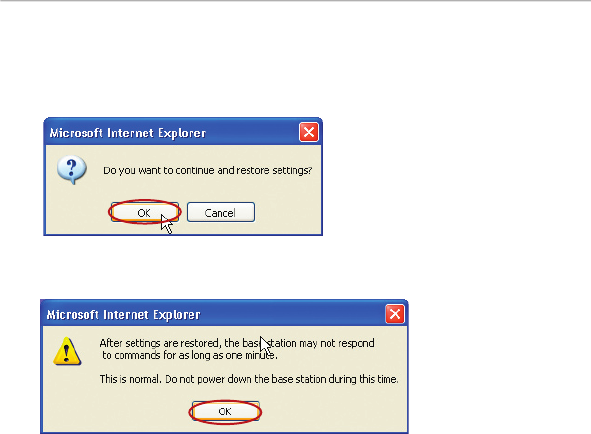
64
Using the Web-Based Advanced User Interface
Using the Web-Based Advanced User Interface
2.
You will be asked if you want to continue. Click “OK”.
3.
A reminder window will appear. It will take up to 60 seconds for
the configuration restoration to complete. Click “OK”.
4.
A 60-second countdown will appear on the screen. When the
countdown reaches zero, the Router’s configuration will be
restored. The Router home page should appear automatically. If
not, type in the Router’s address (default = 192.168.2.1) into the
navigation bar of your browser.
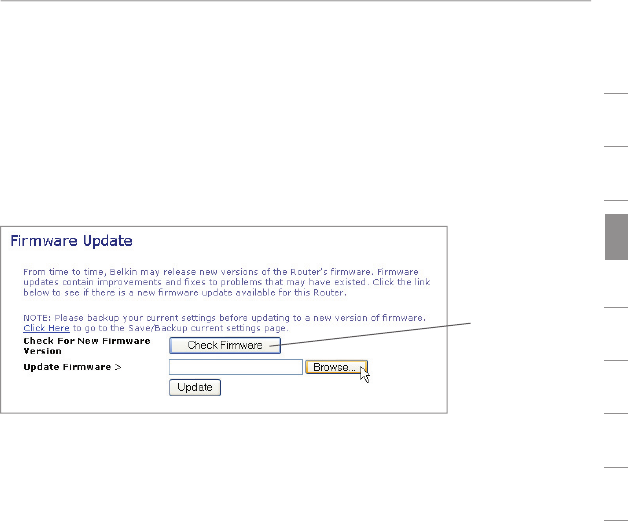
Using the Web-Based Advanced User Interface
65
section
1
2
3
4
5
6
7
8
9
Updating the Firmware
From time to time, Belkin may release new versions of the Router’s
firmware. Firmware updates contain feature improvements and fixes
to problems that may exist. When Belkin releases new firmware,
you can download the firmware from the Belkin update website and
update your Router’s firmware to the latest version.
Checking for a New Version of Firmware
The “Check Firmware”
(1)
button allows you to instantly check for a
new version of firmware. When you click the button, a new browser
window will appear informing you that either no new firmware is
available or that there is a new version available. If a new version is
available, you will have the option to download it.
(1)
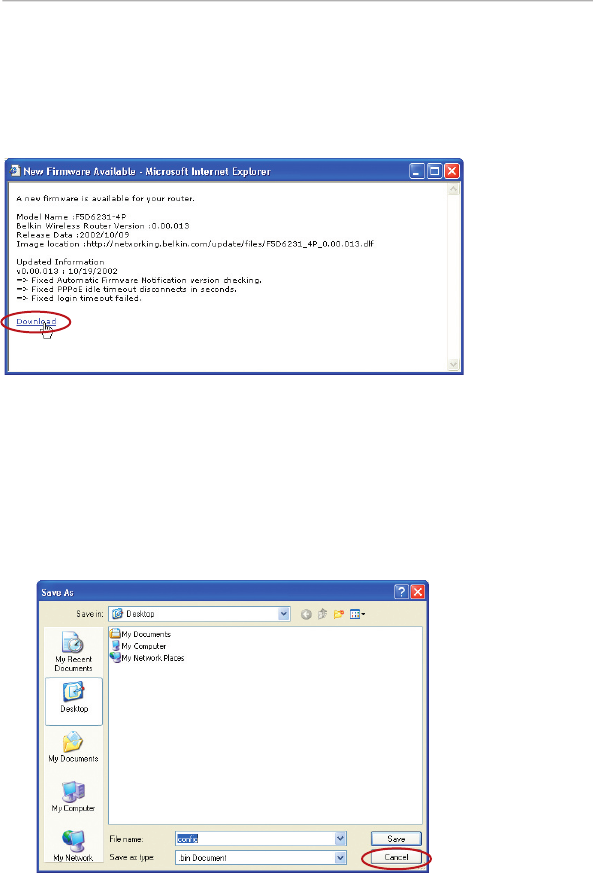
66
Using the Web-Based Advanced User Interface
Using the Web-Based Advanced User Interface
Downloading a New Version of Firmware
If you click the “Check Firmware” button and a new version of
firmware is available, you will see a screen similar to the one below.
1.
To download the new version of firmware, click “Download”.
2.
A window will open that allows you to select the location where
you want to save the firmware file. Select a location. You can
name the file anything you want, or use the default name. Be
sure to save the file in a place where you can locate it yourself
later.
Note:
We suggest saving this to your desktop to locate the
file easily. When you have selected the location, click “Save”.
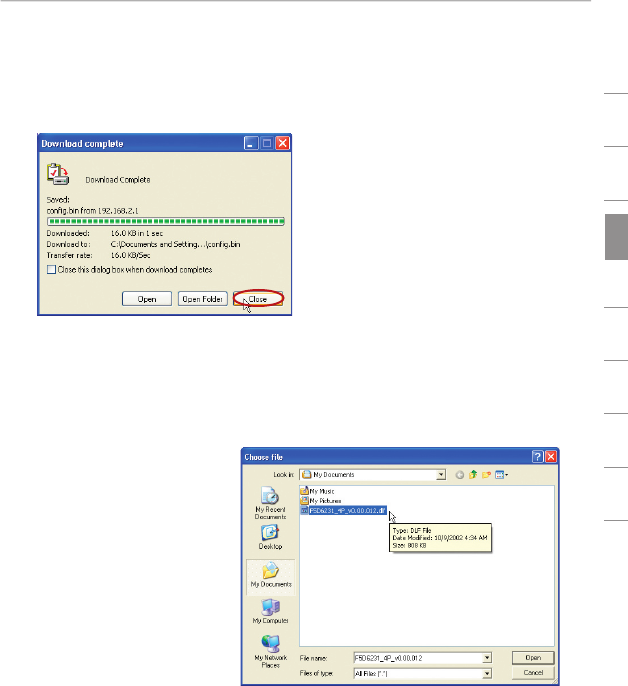
Using the Web-Based Advanced User Interface
67
section
1
2
3
4
5
6
7
8
9
Updating the Router’s Firmware
1.
In the “Firmware
Update” page, click
“Browse”
(2)
. A window
will open that allows
you to select the
location of the firmware
update file.
2.
Browse to the firmware
file you downloaded.
Select the file by
double-clicking on the
file name.
3.
When the save is complete, you will see the following window.
Click “Close”.
The download of the firmware is complete. To update the firmware,
follow the next steps in “Updating the Router’s Firmware”.
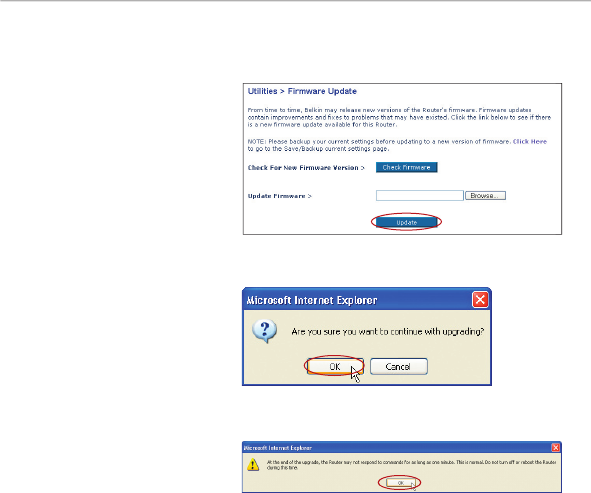
68
Using the Web-Based Advanced User Interface
Using the Web-Based Advanced User Interface
3.
The “Update Firmware”
box will now display
the location and name
of the firmware file you
just selected.
Click “Update”.
4.
You will be asked if you
are sure you want to
continue. Click “OK”.
5.
You will see one more
message. This message
tells you that the Router
may not respond for as
long as one minute as
the firmware is loaded
into the Router and
the Router is rebooted.
Click “OK”.
6.
A 60-second countdown will appear on the screen. When the
countdown reaches zero, the Router firmware update will be
complete. The Router home page should appear automatically. If
not, type in the Router’s address (default = 192.168.2.1) into the
navigation bar of your browser.